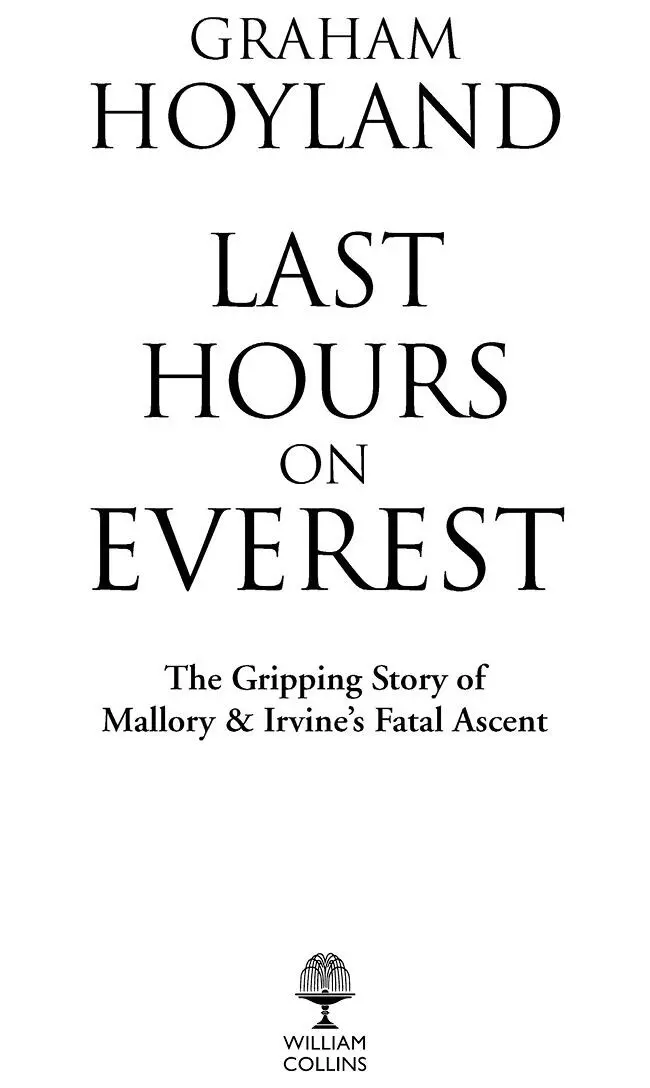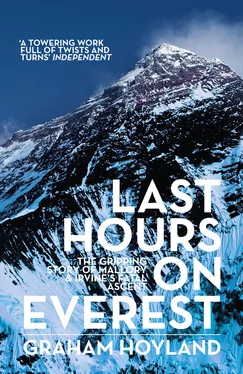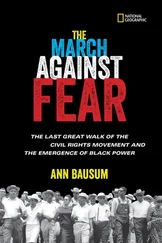
Cover
Title Page
Preface Preface Mount Everest has been my arena. I have spent over two years of my life on the mountain, returning there again and again. I am drawn back because I see there the extremes of human experience played out in the most dramatic surroundings: greed and betrayal, loyalty and courage, endurance and defeat. It is a moral crucible in which we are tested, and usually found wanting. It has cost me my marriage, my home and half my possessions. Twice Everest has nearly killed me. But I find it utterly addictive. And so did George Mallory. This volume is going to add to the vast pile of books about Mount Everest, a pile that must now must be higher than the mountain. I make no apology for this, for I think I have finally solved the mystery of what happened there on 8 June 1924, when Mallory and his young companion Sandy Irvine disappeared into clouds, climbing strongly towards the top. My family had a unique relationship with Everest, and this helped me to climb the mountain and to find clues to what happened to Mallory, its most famous opponent. I spent a long time looking for his body, and then I spent a long time trying to prove that he climbed his nemesis before it killed him. This is going to be a personal story, a detective thriller, a biography and a history book. I hope it will set the record straight about how Mallory was found. It is about other things, too, such as why we believe in gods and mountains. Most of all, though, it is about my life-long hunt for an answer to the greatest mystery in mountaineering: who first climbed Mount Everest?
Prologue Prologue Dawn broke fine on that fatal day. A couple of thousand feet above the tiny canvas tent the summit of the world’s highest mountain stood impassively, waiting for someone to have the courage to approach. Inside the ice-crusted shelter, two forms lay as still as death. Then there was a groan, a stirring, and eventually the slow scratch of match against sandpaper. Low voices shared the high-altitude agonies of waking, the heating of water and the struggle with frozen boots. As the sun rose through wisps of cloud beyond the Tibetan hills to the east, one of the men emerged through the tent flaps. It was a fine morning for the attempt, with only a few clouds in the sky. The two of them stood for a while, shuffling their feet and blowing into their hands. Inside the tent lay a mess of sleeping bags and food. The men lifted oxygen sets onto their backs, then turned towards the mountain and stamped off into history. Seventy years later, above the Hillary Step on the other side of the mountain, I was teetering along the narrow icy summit ridge between Nepal and Tibet, between life and death. The sun was intensely bright and the sky was that deep blue-black of very high altitudes. All around were the icy fins of the world’s highest mountains. And somewhere along that ridge I experienced one of those existential moments that gives you the reason for gambling with your life. The intenseness of the now, the sharp savour of living wholly in the present moment: no past, no worries. The chop of the ice axe, the crunch of the crampons, the hiss of breath – this is the very essence of life. Eventually I saw a couple of figures just above me, a couple of steps … and I was there. I can’t remember much. Now it all seems a sort of vivid dream: bright sunlight, a tearing wind, a long flag of ice particles flying downwind of us. A vast drop of two miles into Tibet. We could see across a hundred miles of tightly packed peaks, and we could see the curvature of the earth. Contorted faces shouting soundlessly, lips blue with oxygen starvation. Doctors prove with blood samples that climbers are in the process of dying up there on the summit, but I would say that is where I started to live. As I stumbled down the mountain one thought kept recurring to me. If I, a very average climber, could stand on this summit, how could the legendary George Mallory have failed to do so?
1 Start of an Obsession
2 Getting the Measure of the Mountain
3 Renaissance Men
4 Galahad of Everest
5 The Reconnaissance of 1921
6 The Expedition of 1922
7 1922, and the First Attempt to Climb Mount Everest
8 ‘No trace can be found, given up hope …’
9 A Pilgrim’s Progress
10 John Hoyland and a New Clue
11 I First Set Eyes on Mount Everest
12 High Mountains, Cold Seas
13 The Finding of Mallory’s Body
14 When Did Everest Get So Easy?
15 Why Do You Climb?
16 What Does Mount Everest Mean?
17 The Theorists and Their Theories
18 Wearing Some Old Clothes
19 Perfect Weather for the Job
20 Utterly Impregnable
21 What Was in His Mind?
22 Weighing the Evidence
23 The Last Hours
Postscript: Goodbye to Everest
Chronology
Notes
Credits
Acknowledgements
Picture Section
About the Author
Copyright
About the Publisher
Mount Everest has been my arena. I have spent over two years of my life on the mountain, returning there again and again. I am drawn back because I see there the extremes of human experience played out in the most dramatic surroundings: greed and betrayal, loyalty and courage, endurance and defeat. It is a moral crucible in which we are tested, and usually found wanting. It has cost me my marriage, my home and half my possessions. Twice Everest has nearly killed me. But I find it utterly addictive. And so did George Mallory.
This volume is going to add to the vast pile of books about Mount Everest, a pile that must now must be higher than the mountain. I make no apology for this, for I think I have finally solved the mystery of what happened there on 8 June 1924, when Mallory and his young companion Sandy Irvine disappeared into clouds, climbing strongly towards the top.
My family had a unique relationship with Everest, and this helped me to climb the mountain and to find clues to what happened to Mallory, its most famous opponent. I spent a long time looking for his body, and then I spent a long time trying to prove that he climbed his nemesis before it killed him.
This is going to be a personal story, a detective thriller, a biography and a history book.
I hope it will set the record straight about how Mallory was found. It is about other things, too, such as why we believe in gods and mountains.
Most of all, though, it is about my life-long hunt for an answer to the greatest mystery in mountaineering: who first climbed Mount Everest?
Dawn broke fine on that fatal day. A couple of thousand feet above the tiny canvas tent the summit of the world’s highest mountain stood impassively, waiting for someone to have the courage to approach.
Inside the ice-crusted shelter, two forms lay as still as death. Then there was a groan, a stirring, and eventually the slow scratch of match against sandpaper. Low voices shared the high-altitude agonies of waking, the heating of water and the struggle with frozen boots.
As the sun rose through wisps of cloud beyond the Tibetan hills to the east, one of the men emerged through the tent flaps. It was a fine morning for the attempt, with only a few clouds in the sky. The two of them stood for a while, shuffling their feet and blowing into their hands. Inside the tent lay a mess of sleeping bags and food. The men lifted oxygen sets onto their backs, then turned towards the mountain and stamped off into history.
Читать дальше













